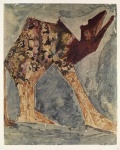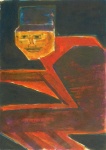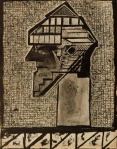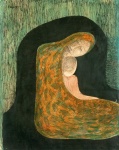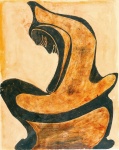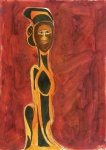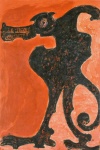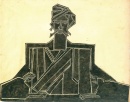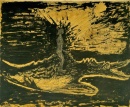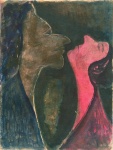Rabindranath Tagore
Rabindranath Tagore was a Bengali poet, painter, philosopher, and composer who was awarded the Nobel prize for literature. He was heavily involved with members of the Theosophical Society in England and India.
Personal life
Rabindranath Tagore was born on May 7, 1861 in Kolkata, India. His father, Maharshi Devendranath Tagore, was a Hindu philosopher and reformer, active in the Brahmo Samaj. He established the guest-house called Santiniketan ("the abode of peace") in West Bengal, north of Kolkata.
Tagore died at the age of eighty on August 7, 1941 at Jorasanko Thakurbari in Kolkata.
Tagore and Theosophical Society
G. Sundari was born in 1929. She has had a lifelong association with both the Theosophical Society and Kalakshetra dance academy. She worked at Kalakshetra for 33 years, first as the Superintendent of Studies, and later as the Assistant Secretary of Performances for over two decades.
She remembers Rabindranath Tagore in following words:
My father came to Madras at the request of Annie Besant to work in the Theosophical Publishing House, and the rest of us followed when the Besant Theosophical School opened in 1934. I joined the school in Class I, and studied there till I completed my SSLC [Secondary School Leaving Certificate].
One of my earliest memories is of seeing Rabindranath Tagore during his visit to Madras in 1934. He was very impressive, with his ochre robes and his long beard. He had come with his students as part of his South India tour to raise funds for Shantiniketan. The president of the Society, George Arundale told him, ‘Gurudev, we don't want you to have to go around collecting funds at your age,' and assured him that they'd collect the money for him. So Tagore stayed on at the Society for about 10 days, and was well taken care of at the Blavatsky Bungalow near the big banyan tree.
All of us children would run in and out of the bungalow — there were no restrictions on our movements. Tagore would be reclining in an easy chair in the hall and when a child went up to him, his arm would go gently around him or her. But what fascinated us most was the sight of his students combing out his long beard! The Theosophical Society was in general a very child-friendly place. Dr. Arundale wouldn't pass by a child without a smile and a wave.[1]
A plaque commemorates his stay in the historic Blavatsky Bungalow from October 21 to November 2, 1934:
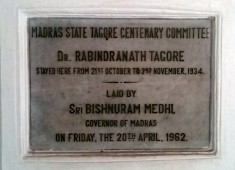 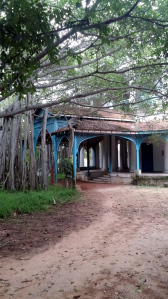
|
Involvement with education
Visva-Bharati
Tagore founded Visva-Bharati in his father's community of Santiniketan, which expanded into a university town. In 1951 Visva-Bharati was established as a national central university.
Besant Theosophical College
Besant Theosophical College is one of the oldest colleges in the Rayalaseema Region of Andhra Pradesh. The college started on 19 July 1915. (It was established decades before Sri Venkateswara University.) Initially it was affiliated with Madras University. In 1917 it was forced to dissociate itself from Madras University and became part of National University. Dr. Rabindranath Tagore was the chancellor of the university.
In 1919, Tagore visited the college and during this time translated the lyrics of the Indian national anthem, "Jana Gana Mana", which he had previously written, from Bengali to English. Margaret Cousins (an expert in European music and wife of Irish poet James Cousins, then vice-principal of the college) set down the notation to the national anthem in the college, which is followed only when the song is sung in the original slow rendition style.
During Tagore's visit, the Scout Movement and All India Women Association were inaugurated at Madanapalle.
In 1923, the college was re-affiliated with Madras University and continued for almost 30 years. After the separation of Andhra State and Madras State, the college was affiliated with Andhra University (1954–1956) and then with Sri Venkateswara University, Tirupati.
Poetry
THIS SECTION UNDER CONSTRUCTION
THIS SECTION UNDER CONSTRUCTION
Tagore was lionized in Europe.
Tagore visited Germany thrice – in 1921, 1926 and 1930. Two dozen of his books were already available in German translation. "Wherever he spoke, the halls were packed. The newspapers reported scuffles and regular fights by people who were refused entry, " say Martin Kampchen, a German author who has translated Tagore's works. The local media hailed the india poet as the 'Wise man from the East'; and a 'prophet, a mystic and a messiah'. [2]
Paintings
While Tagore is best-known for his writing, he was also heavily engaged in painting. He was the father of the Indian art movement of contextual modernism, a school of art that was cross-cultural, experimental, and humanist. Art Nouveau and ancient Indian crafts inspired some of his art.
Tagore began painting in his mid-sixties and ended up producing more than 2,300 artworks over a decade before he died in 1941.
"He always wanted to paint. He was doodling in his manuscripts. Around 1928, he was producing his first paintings," says Professor Siva Kumar.[3]
His was the first Indian art to be exhibited across Europe, Russia and the United States.
In 1930, a solo show carrying some 300 of Tagore's artworks travelled to Europe. More than 100 of his paintings were shown in Paris, and at least half of them at the National Gallery of Art in Berlin before the exhibition proceeded to London.[4]
The artist donated five of his works to the German museum. Adolph Hitler, however, found the works to be degenerate, along with most other modern art.
They were five artworks in all, depicting birds and humans, and one of a girl in a red robe.
Painted in coloured inks and gouache by Rabindranath Tagore, india's most famous poet, they found a place in a leading museum in Berlin. Tagore, the first non-European to win the Nobel literature prize, had gifted the paintings to Germany in 1930.
Seven years later, the paintings were purged by the Nazi regime which had begun to classify some "inappropriate" art works as degenerate.
Hitler, a failed artist himself, believed post-impressionist modern art to be "evidence of a deranged mind" and ordered more than 16,000 artworks, including ones by Van Gogh and Man Ray, to be removed from German museums.
The Nazis considered such art "degenerate" and even staged an exhibition to ridicule them...
Until 1937, Tagore's paintings were housed in Berlin's baroque Crown Prince Palace, which also housed the National Gallery. When Hitler's purge began, a "deportation list from 15 October 1937 shows the five paintings listed amongst those of many famous expressionist painters which were removed from the palace and brought to a depot with restricted access in the city", according to art historian Konstantin Wenzlaff. [5]
The location of the five paintings remains uncertain.
Museums
- Jorasanko Thakurbari, Rabindranath Tagore's Home and Museum, in Kolkata. This was the ancestral home of Rabindranath Tagore. Many of his personal effects on display, along with paintings him, his brother Abanindranath Tagore, and other painters.
- Tagore Museum, Shantiniketan or "Rabindra Bhavan" also houses a research institute and a library. It is in the city where Tagore lived, and the museum displays his belongings, art, musical instruments; his Nobel medal and diploma; and souvenirs and gifts from all over the world.
Many of the world's great museums have collected his art:
Exhibitions
The Last Harvest was an event celebrating the 150th anniversary of the artist's birth. Three similar selections totaling 208 paintings were shown simultaneously in three circuits. Museums hosting the exhibitions were in Germany, England, the United States, Korea, India, Malaysia, Canada, France, and Italy, opening in 2011.
Rabindranath Tagore: Rhythm in Colours was held May 3-7, 2018 at the Maulana Azad Centre for Culture of the Embassy of India in Cairo.
Mutual Art maintains a list of Tagore exhibitions.
Gallery
Here are some example of Tagore's art:
Honors and awards
THIS SECTION UNDER CONSTRUCTION
THIS SECTION UNDER CONSTRUCTION
Additional resources
Articles
- Rabindranath Tagore at The Open University's website on "Making Britain: Discover how South Asians shaped the nation, 1870-1950." Accessed November 3, 2016.
Books
- Robinson, Andrew. The Art of Rabindranath Tagore. 1989.
- Rabindranth Tagore: A Celebration of His Life and Works. Rabindranath Tagore Festival, 1986.
- 'Six Indian Painters', Tate Gallery, London, 1982.
- Dutta, Krishna, and Andrew Robinson. Rabindranath Tagore: The Myriad-Minded Man. London: Bloomsbury Publishing Ltd., 1995.
Videos
- "Tagore as an Artist and His Influence on Modern Indian Art" by Professor Raman Siva Kumar at Smithsonian Institution. July 26, 2011.
- "Paintings of Rabindranath Tagore: A Perspective" by Professor Raman Siva Kumar at Smithsonian Institution. July 27, 2011.
Websites
Notes
- ↑ Sundari reference.
- ↑ Soutik Biswas, "Rabindranath Tagore: When Hitler purged India Nobel laureate's painting" in BBC News.
- ↑ Soutik Biswas, "Rabindranath Tagore: When Hitler purged India Nobel laureate's painting" in BBC News.
- ↑ Soutik Biswas, "Rabindranath Tagore: When Hitler purged India Nobel laureate's painting" in BBC News.
- ↑ Soutik Biswas, "Rabindranath Tagore: When Hitler purged India Nobel laureate's painting" in BBC News.





